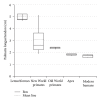Morphometric and statistical analysis of the palmaris longus muscle in human and non-human primates
- PMID: 24860810
- PMCID: PMC4016873
- DOI: 10.1155/2014/178906
Morphometric and statistical analysis of the palmaris longus muscle in human and non-human primates
Abstract
The palmaris longus is considered a phylogenetic degenerate metacarpophalangeal joint flexor muscle in humans, a small vestigial forearm muscle; it is the most variable muscle in humans, showing variation in position, duplication, slips and could be reverted. It is frequently studied in papers about human anatomical variations in cadavers and in vivo, its variation has importance in medical clinic, surgery, radiological analysis, in studies about high-performance athletes, in genetics and anthropologic studies. Most studies about palmaris longus in humans are associated to frequency or case studies, but comparative anatomy in primates and comparative morphometry were not found in scientific literature. Comparative anatomy associated to morphometry of palmaris longus could explain the degeneration observed in this muscle in two of three of the great apes. Hypothetically, the comparison of the relative length of tendons and belly could indicate the pathway of the degeneration of this muscle, that is, the degeneration could be associated to increased tendon length and decreased belly from more primitive primates to those most derivate, that is, great apes to modern humans. In conclusion, in primates, the tendon of the palmaris longus increase from Lemuriformes to modern humans, that is, from arboreal to terrestrial primates and the muscle became weaker and tending to be missing.
Figures


References
-
- Standring S. Gray’s Anatomy the Anatomical Basis of Clinical Practice. London, UK: Churchill Livingstone; 2008. Pelvis girdle and lower limb.
-
- Gray H. Gray Anatomia. Rio de Janeiro, Brazil: Guanabara Koogan; 1979. Membro superior.
-
- Telles VS, Ernesto BAL. Consideraciones anatómicas de los músculos inconstantes. MedUnab. 1998;1(3):165–170.
-
- Cope JM, Looney EM, Craig CA, Gawron R, Lampros R, Mahoney R. Median nerve compression and the reversed palmaris longus. International Journal od Anatomical Variation. 2009;2:102–104.
Publication types
MeSH terms
LinkOut - more resources
Full Text Sources
Other Literature Sources

